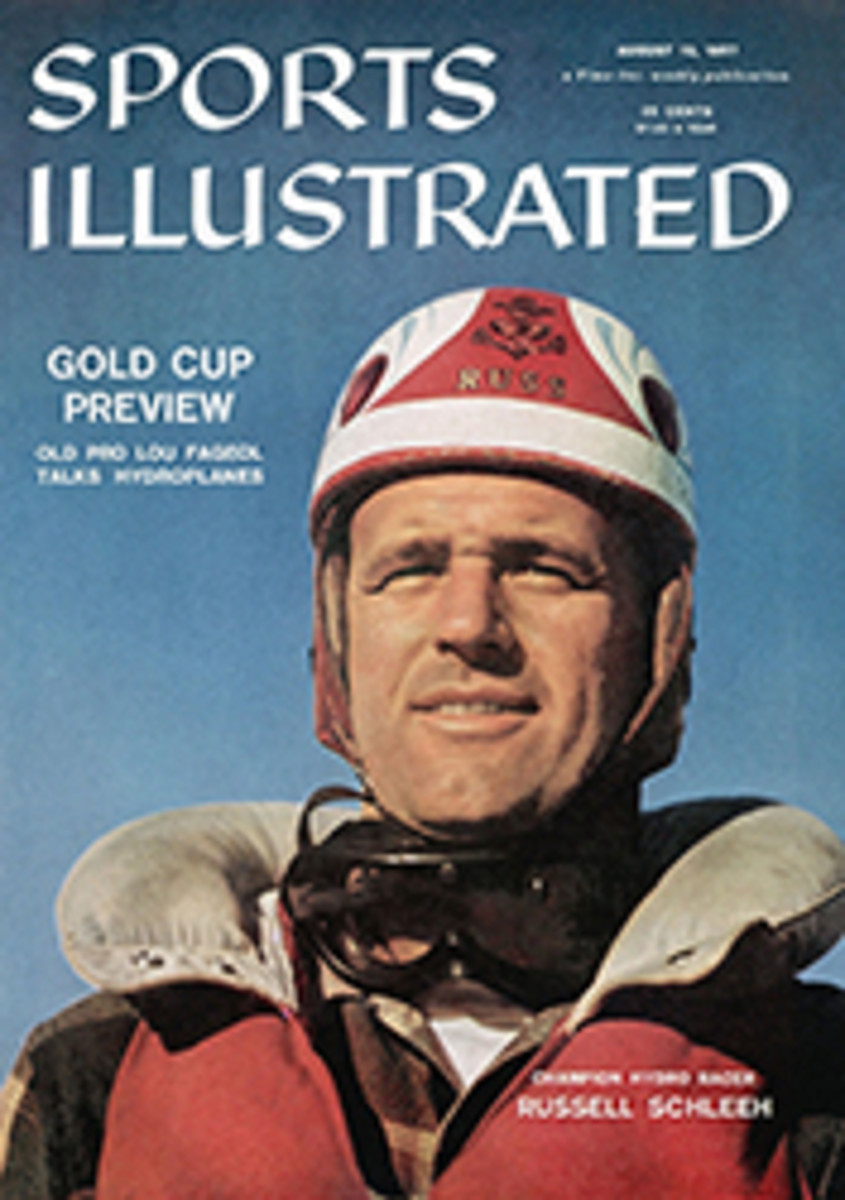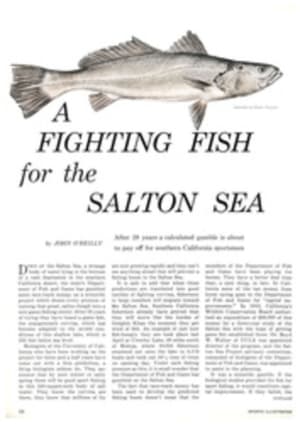
FLAGS IN THE FRONT YARD
Owning a private golf course is a little like owning a private Hudson River excursion steamer, or a private operating table, or a private mallet locomotive and 50 private refrigerator cars; once you've got the thing you must figure out what to do with it. There is probably nobody in the U.S. better fitted to solve this problem than Lowell Thomas, the radio newscaster, who is the proud owner of the little (80 acres) course pictured on these pages. Thomas has devoted a great deal of his life to what might be described as the care and handling (and, at times, the creation) of celebrities; he has a sort of cattleman's knack of turning them into his corral on command and of moving among them at will without being gored. The private golf course affords him wonderful opportunities for grouping and exercising them, and there have been days when he has been able to ride his private electric caddie cart among some very impressive specimens of American longhorn.
Even so, there are times when he is a little startled at finding poles with little flags on them in plain sight of the front door of his house near Pawling, N.Y. This is unusual, for the rarity of private golf courses is only partially induced by the financial outlay which they involve. A man who is not a grass lover and a tree inspector by nature could hardly be expected to saddle himself with acres of both; conversely, he could be as sod-happy as a mole and keep the lid on his id by simply buying a farm, or a private cemetery and headstone works. Some vast, motivating urge must obviously be necessary in most cases; the late Comedian Joe Cook, for instance, liked laughs and burned to shoot a hole in one and was thus moved to construct a green shaped like a funnel. The Thomas course, however, came as a kind of afterthought in a life devoted to achieving simple princeliness and is so mixed up in his mind with innumerable other projects that he tends to classify it with his softball diamond, his local ski tow, his international fireplace (stones from all parts of the world), his stand of small dawn sequoias (from deepest Yunan province) and, at times (while on "expeditions"), to forget all about it.
Building the course, it should be explained, was easy enough—he already had 80 acres of rolling meadowland around his home and the men and machinery to keep it in shape. Laying the foundation upon which it rests, however, was another matter; Thomas built his baronial establishment out of nothing more solid than air, and did so when more orthodox American grandees were sliding into obscurity by the hundreds on the banana peel of the Great Depression. One of these was a man named Fred F. French—who got enormously rich during the 1920s by building skyscrapers in New York—and Thomas still feels indebted to him both for his grandiose concepts and his lack of foresight.
At the height of the great boom after World War I, French decided to establish a family seat worthy of his stature and accomplishments. He found the site at Quaker Hill, a lovely section of elevated forest and farm land near the Connecticut line, 75 miles north of New York City. He bought up thousands of acres of it, then tore down all the farmhouses included in 'his domain, planted long vistas of Norway spruce, and built, at a cost of $400,000, a great, 15-bathroomed Georgian house. When it was done, he was able to stand before it and remark that everything the eye could see was his. He went broke almost immediately and died shortly thereafter of angina pectoris.
Meanwhile, Thomas—an Army doctor's son who had grown up at Cripple Creek, Colo., had punched cattle, sampled the academic offerings of four colleges, and had gotten a start in life as a cub reporter in Cripple Creek—was proving that a man could get rich as quickly by talking as by plunging in the market or drilling oil wells. He held millions of Britons spellbound with an illustrated lecture on Lawrence of Arabia (whom he had cannily sought out in the desert during World War I), toured the Caribbean with another lecture on Germany's sea raider, Count von Luckner, became the voice of Movietone newsreel and succeeded the late Floyd Gibbons before the microphone on the first U.S. radio news program—a position of eminence which was later to bring him nearly a half million dollars a year.
He was—and still is, at 65—ferociously addicted to sport. He loved to ride, had learned to ski in Europe in 1919 (he is now associated with Insurance Tycoon C. V. Starr in operating the great ski resort at Stowe, Vt.), and decided to make the electronic age conform to his pattern of life. Although it strained his finances to the cracking point, even at Depression prices, he bought up the whole enormous French holdings at Quaker Hill and moved into the great house. Eventually, by installing radio equipment in a barnlike studio outbuilding, he arranged to do his broadcasts at home, thereby freeing himself to indulge his passion for sport and his flair for grandly steering others toward his kind of living.
The private golf course was doubtless inevitable from that point on, although Thomas kept busy at other works for some time. The new squire of Quaker Hill spurned his predecessor's policy of isolation and, although he kept a tidy 3,000 acres for himself, allowed selected supplicants (among them New York's Thomas E. Dewey and television's Edward R. Murrow) to buy land in the country around him and to be swept along in the tide of his projects and enthusiasms. In the 1930s he went mad for soft-ball and enrolled his friends and neighbors in a team known as the Nine Old Men, which engaged in spirited battles with a team of White House correspondents and Secret Servicemen organized by President Franklin D. Roosevelt; other celebrities were also lured to the plate, among them Westbrook Pegler, Dale Carnegie, Gene Tunney and even, at one point, Babe Ruth—who struck out.
Though his softball period was quickly followed by his present golf period, Thomas was kept so busy learning—or at any rate trying to learn—the game, and mulling over its frustrations and admiring its subtleties, that he did not immediately realize that there was golfing terrain at his very door. When a friend remarked on this fact one day four years ago, Thomas responded with alacrity; he discovered that a New Hampshire horticulturist would truck in and lay pregrown greens, ordered four, had the grass cut and, in only a fortnight, was enthusiastically operating the Hammersley Hill Golf (and Hunt) Club.
He has enlarged it since. Having installed what he conceives to be the shortest hole in the world (80 yards), he laid in the longest, which is almost one-half mile from tee to green. It is now possible to play either nine or 12 holes; the first setup being known as the Vice-Presidential course and the second as the Presidential course, in celebration of the fact that Ike and Dick Nixon have both been guests at Quaker Hill. Although ex-President Herbert Hoover is also a spasmodic visitor and, in fact, smuggled a stone out of Hitler's bunker under his coat for Thomas' fireplace a few years ago, he has yet to have a hole named after him.
To demonstrate the course in action, Thomas gathered a representative group of "members" a few days ago and put them through their paces. Several professionals reported, among them the irrepressible Gene Sarazen, who prepared for action by rolling up his pants, thrusting a cigar into his mouth, making a short speech on behalf of the Wilson Sporting Goods Company, which retains him as a sort of peripatetic exhibit. Pat Hogan, a friend of ex-Governor Dewey (who sent his regrets); Robert Trent Jones, the golf course architect; Edward R. Murrow; an editor; a publisher; Richard C. Doane, president of the International Paper Company, and his wife Mary; assorted lady golfers and a couple of neighbors from Quaker Hill composed the rest of the cast. Thomas bustled about among them as solemnly as the tournament director at the National Open, divided them into three foursomes, sent them on their way, teed off himself and then hurried to his electric caddie cart to follow with a cargo of bags.
In observing him, as the pleasant, sunny day progressed, it was impossible not to look for some covert sign of, well, satisfaction. Very few golfers have private courses, after all, and Thomas would have been only human if he had paused, somewhere along the line, and struck at least one pose. He only bustled; his air was not exactly that of a missionary among the heathen, for his guests were obviously converts already, but it would not be inaccurate to suggest that his attitude was that of a Billy Graham briefing his advance men. Golf to Thomas is something the world needs, and he was obviously a Man with Work to Do. After lunch at the studio (beer, hamburgers, salad and ice cream), he made what seemed at first to be an astounding gesture of abnegation: he suggested that better golf was possible on the nine-hole Quaker Hill course only five minutes away and asked everyone to join him there. It turned out in the end, however, that he had built it too.
PHOTO
RICHARD MEEK
GOLF-DAY GUESTS include a mélange of personalities. Left to right: Golf Architect Robert Trent Jones, Thomas' Financial and Business Manager Frank M. Smith, Edward R. Murrow, Golfer Gene Sarazen, Thomas, Connecticut Pro George Ferrier, neighbor (and great friend of former Governor Tom Dewey) Carl T. Hogan, and Bill Goldbeck, professional at the Mt. Kisco Country Club. On opposite page is a facsimile of the four-page score card which Thomas drew up to lend his 80-acre course tone and personality—a card which he revises with vast gusto whenever he decides to devise newer "traditions" for the Club.
FOUR PHOTOS
PHOTO
RICHARD MEEK
A TRICKY SHOT and a lovely Quaker Hill view: Mrs. John P. Sawyer lofting her ball across a bass pond, with her host's spacious Georgian house in the background. Thomas cannot but wonder how his fish react when guests plop careless shots into the water.
PHOTO
RICHARD MEEK
STAR TV COMMENTATOR Edward R. Murrow, a man with a ferocious swing, punishes ball after arriving from his nearby farm.
TWO PHOTOS
RICHARD MEEK
HOST THOMAS (above) standing behind his electric caddie cart. Below: presiding at lunch for golfing friends in his big studio.

